Since its founding in 1979, the Bible Museum in Münster has collected a multitude of artefacts that illuminate the living history of the Bible—from its inception as a written text to the modern day. Many of these objects highlight the development and transmission of the New Testament text. In addition to Coptic, Syriac and Latin manuscripts, the Greek manuscripts in the collection[1] are of particular importance as carriers of the original language of the New Testament.

Altogether the Bible Museum houses 23 Greek NT textual witnesses: 2 majuscules, 11 minuscules, and 10 lectionaries, making it the third largest collection of Greek NT manuscripts in Germany.[2]
In addition, 6 New Testament papyri from the 3/4th century are currently on loan at the Museum from Cologne (Institut für Altertumskunde) and Berlin (Staatliche Museen). Visitors have the unique opportunity to view P8, P25, P66, P86, P87, P118 until Sept. 29, 2024.
This blogpost briefly introduces the manuscripts in the collection based on information from my new catalogue, published on the occasion of the Bible Museum's 45th anniversary. (Many thanks to Katie Leggett for summarizing and translating the catalogue for this blogpost.)

For much more detailed information see here.
Majuscules
GA 0233 Bibelmuseum Ms. 1
8th century Gospel manuscript, written in majuscule with 93 parchment folios that were removed in the 13th century, trimmed, and rewritten to create GA L1684 (see below). The manuscript measures 270x210 mm with 2 columns and 23-27 lines per folio.

On fol. 128v of GA 0233 the undertext, John 2:12-15, is visible
GA 0301 Bibelmuseum Ms. HKS 677
The museum's oldest Greek NT witness, this single fragment is from a miniature 5th century manuscript (68x70 mm).[3] It has only 14 lines per side and contains John 17:1-4, the beginning of the High Priestly Prayer. It's not possible to decide definitively if this text originated from a Gospel codex or was part of a commentary manuscript. It is also possible—due to its small size—that the text was created for everyday use and perhaps worn as an amulet.

GA 0301 with John 17:1-2 on the recto side
Minuscules
GA 676 Bibelmuseum Ms. 2
13th century on parchment, 344 leaves with the Gospels, Acts of the Apostles, Pauline Epistles and Catholic Letters (196x150 mm), 1 column with 28 lines
A critical eye will notice that this codex was written by two different scribes: the first penned the Gospels and the second the rest. In the 14th century, beautiful illuminations of the evangelists on gold leaf in vivid colors were added to the Gospels (fol. 9, 57, 140). They were painted over (palimpsest) an 11th century theological text. The illustration of Luke is unfortunately missing.

Illustration of John the Evangelist in GA 676 (fol. 140v)
GA 798 Bibelmuseum Ms. 7
11th century Gospel manuscript on parchment containing 148 of 260 total leaves (170x115 mm), 1 column with 20 lines (occasionally 21 or 22)
The 148 leaves at the Bible Museum contain Luke and John. They belong together with the 112 folios held at the National Library in Athens EBE 137 containing the Gospels of Matthew and Mark.

Fol. 89r with the beginning of Mark (left) held in Athens and fol. 96r. with John (right) held in Münster (GA 798)
GA 1432 Bibelmuseum Ms. 3
12th century Gospel manuscript on parchment with 225 folios, 1 column with 28 lines. At 147x115 mm, it's the smallest bound codex in the collection.
This manuscript was formerly in the possession of the Skete of St. Andrew on Mount Athos, whose western wing and library were partially destroyed by fire in July 1958. The Gospel text is complete, only the Kephalaia before the Gospels of Matthew and Mark seem to be missing. The manuscript boasts colorful canon tables and intricate frames of the Gospels decorated in gold, blue, green and red.
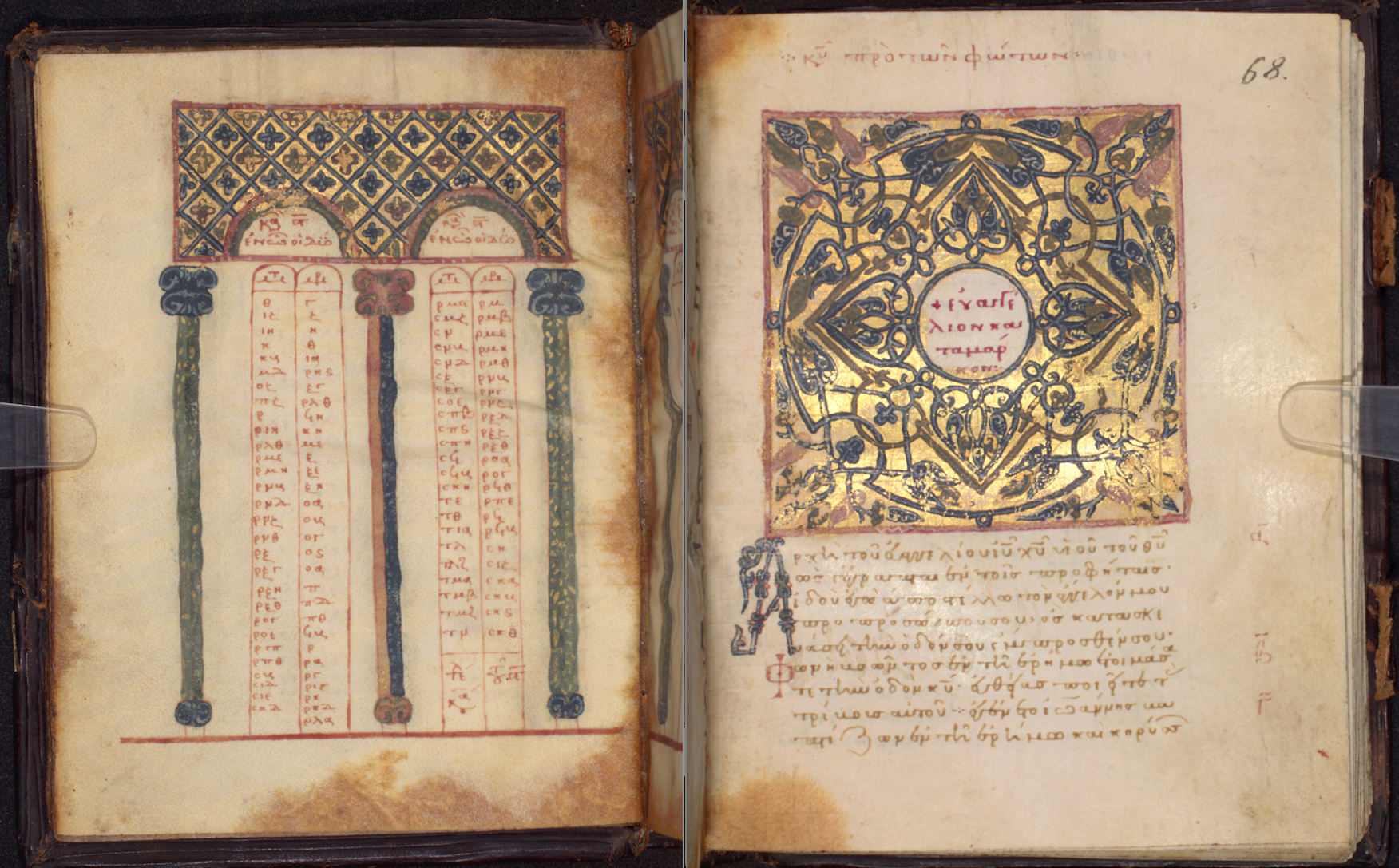
Ornate canon tables of GA1432 (fol. 5r) and the elegant beginning of the Gospel of Mark (fol. 68r)
GA 2444 Bibelmuseum Ms. 4
This 13th century Gospel manuscript measures 220x150 mm with 308 leaves, 1 column and 22 lines. It is the only minuscule on paper in our collection.
The geometric and floral ornamentations as well as the opulent, oversized initials in black and red at the beginning of each Gospel are particularly noticeable.

Folio 2r of GA 2444 showing the beginning of the Gospel of Matthew
GA 2445 Bibelmuseum Ms. 5
12th century Gospel manuscript on parchment, 116 leaves (163x130 mm), 1 column with 20-22 lines
Numerous leaves are missing at the beginning (all of Matthew and Mark 1:1-7:9) and the end (from John 7:33 to the end) as well as other individual leaves throughout the codex. The text was written by two different hands: the first part with 20 lines per folio and the Gospel of John from with 22 lines per folio.
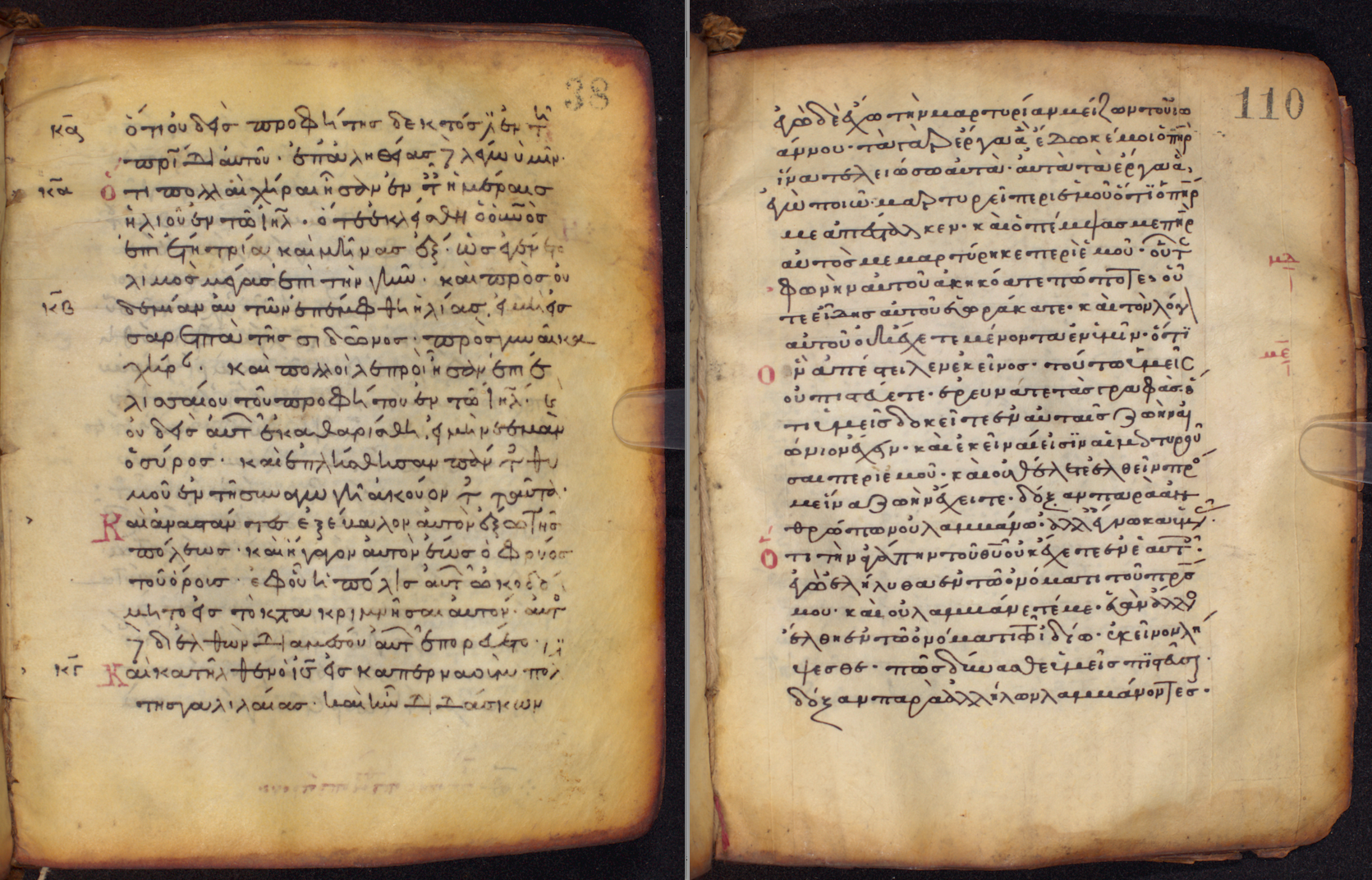
GA 2445 left image showing the hand of Luke (fol. 38r) and right (fol. 110r) showing John
GA 2446 Bibelmuseum Ms. 6
12th century Gospel manuscript with 320 leaves on parchment (168x128 mm), 1 column with 20 lines
Curiously, numerous folios of this manuscript have been replaced at about the same time it was written or shortly thereafter. It appears that the original leaves were carefully cut out and replacement folios were adapted to them, but with a different ruling (e.g. fol. 36, 38, 44, 50).

Folio 50v of GA 2446 shows on the right where the new folio was bound in the codex.
GA 2460 Bibelmuseum Ms. 19
8 leaves of a 13th/14th century Gospel manuscript with Matthew 18:32-22:9 on parchment (240x170 mm), 1 column with 26 lines
The bulk of this Gospel manuscript (195 leaves) resides in Ioannina, Greece (Zosimaia School, 2), and two leaves are at Columbia University (Plimpton Ms.12).
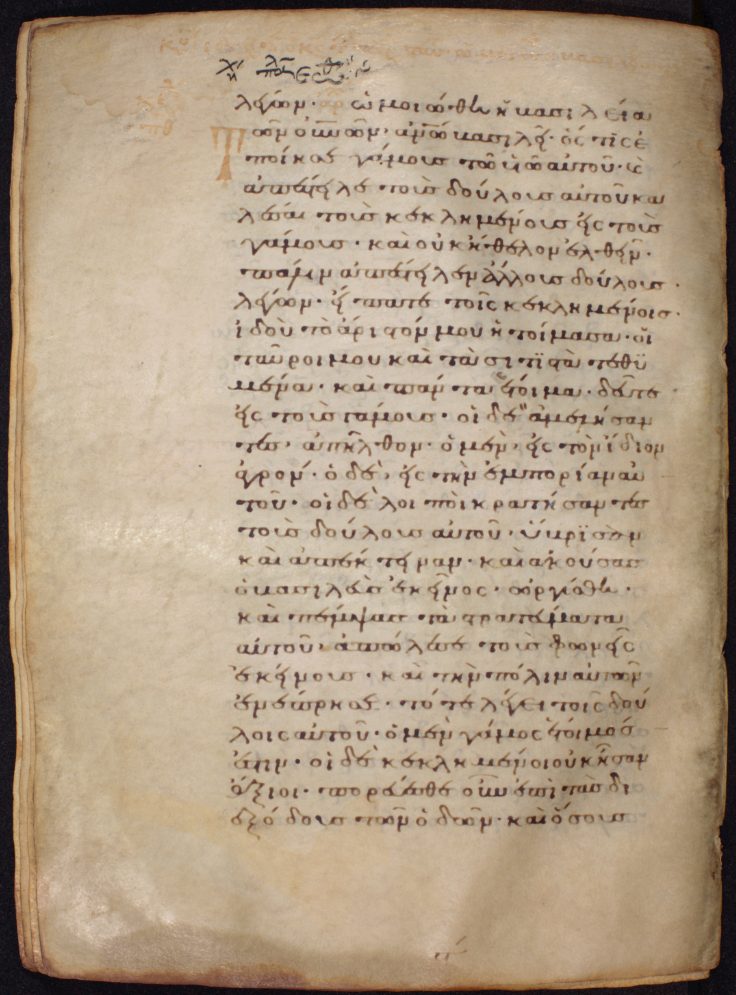
Fol. 24v. of GA 2460 with text of Matthew 22:1-9
GA 2754 Bibelmuseum Ms. 8
11th century Gospel manuscript on parchment with 256 leaves (193x143 mm), 1 column with 25-26 lines per folio
Various marginal notes (fol. 77v; 138v; 151v; 199r; 228v) refer to the church της περιβλεπτου Βερροιας (Veria) in northern Greece from which the manuscript originally came. An interesting feature is the Kephalaia for Matthew, which was added by a later hand on fol. 75r-76v using pages that were blank. The later scribe drew 12 simple circles with the names, origin, places of activity, and martyrdoms of the 12 apostles.

Fol. 75v of GA 2754 showing 8 of the 12 circles referring the Apostles and below the continuation of the Kephalaia for Matthew
GA 2755 Bibelmuseum Ms. 9
11th century Gospel manuscript on parchment, with commentary on Matthew and Mark (322x232 mm), 1 column with 29 lines
With 370 folios this is our most voluminous codex and our sole commentary manuscript. There are two additional leaves in Cambridge (Ms. Add. 4490), and some leaves of the original codex are still missing, especially at the end. The commentaries are very extensive e.g., just the first two words of the Matthew's Gospel, βιβλος γενεσεως, comprises 3.5 pages.

Fol. 7r of GA 2755 showing βιβλος γενεσεως (five lines from the bottom) written in semiuncial
GA 2756 Bibelmuseum Ms. 10
13th century Gospel manuscript on parchment with 195 leaves (187x145 mm), 1 column with 25 lines per folio
The text is complete, except the final page of John. It has elegant illuminations of all four evangelists that originate from another manuscript and were inserted later as enhancements (fol. 6, 63, 99, 156).
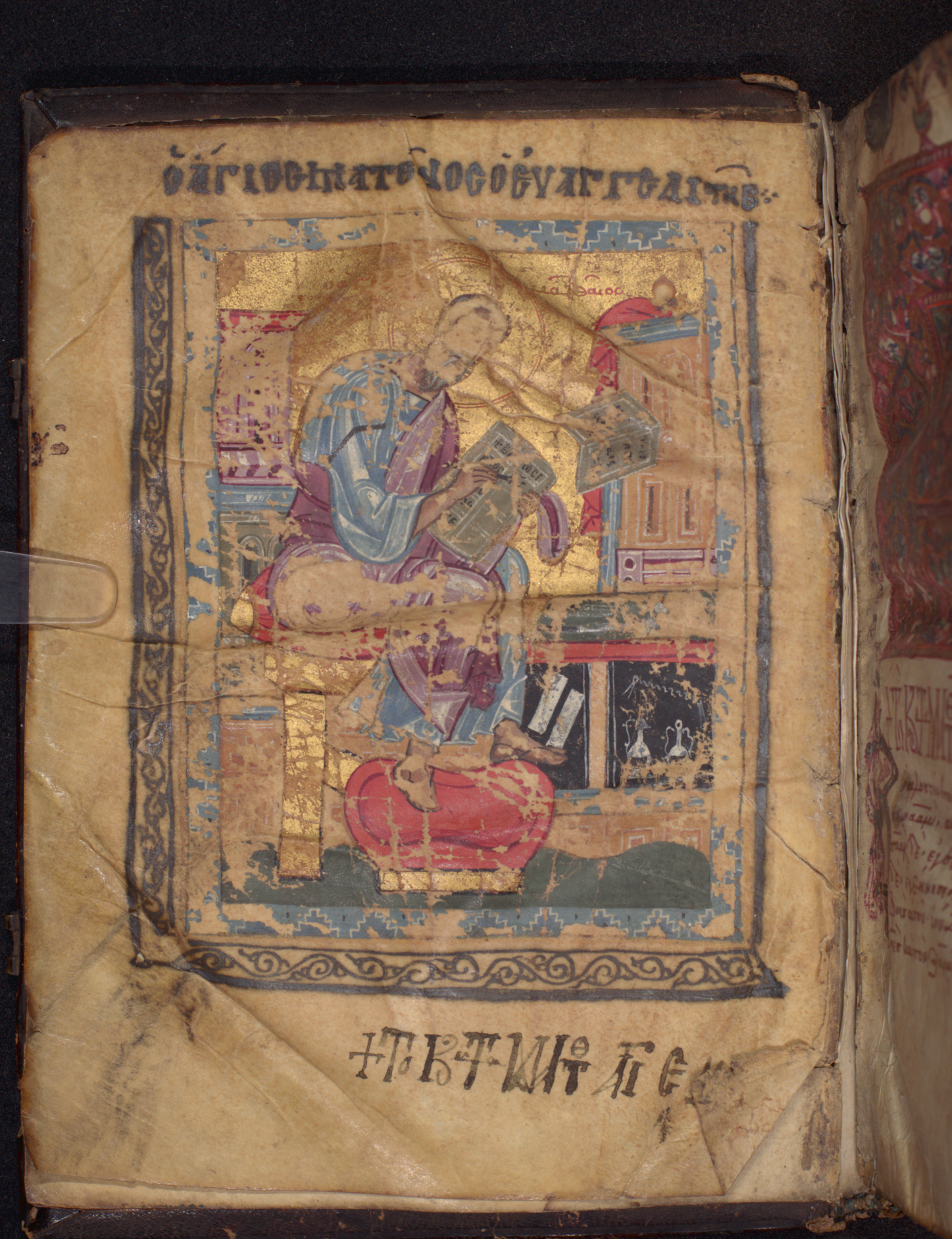
GA 2756, illumination of Luke (fol. 99v)
GA 2793 Bibelmuseum Ms. 11
13th/14th century single leaf on parchment from a Gospel manuscript with Matthew 22:7-22 (139x103 mm), 1 column with 20 lines
The leaf was sold in 1853/54 by Konstantinos Simonides, an infamous forger of ancient Greek texts, to Sir Thomas Philipps (1792-1872) who was an English collector of antiquities. Hermann Kunst acquired the sheet in 1973 from Bernard Quaritch Ltd.

Frontside of GA 2793 showing Matt 22:7-14
Lectionaries
GA L1681 Bibelmuseum Ms. 12
15th century Gospel lectionary with 187 leaves on paper (215x150 mm), 1 column with 26-28 lines per folio
This lectionary along with L1682, L1684, L2208, and L2276 in our collection contain Gospel readings for every day of the week from Easter to Pentecost as well as readings for Saturdays and Sundays.
At the end of the lectionary, the scribe concludes his work with a colophon:
δόξα σοι ὁ θεὸς ἡμῶν δόξα σοι ̇ ἀμήν.
σωθῆ ὁ ἔχων ̇ ἐλεηθῆ ὁ γράψας.
Honor be to you, our God, glory be to you. Amen.
May the owner be saved, may the writer find mercy.
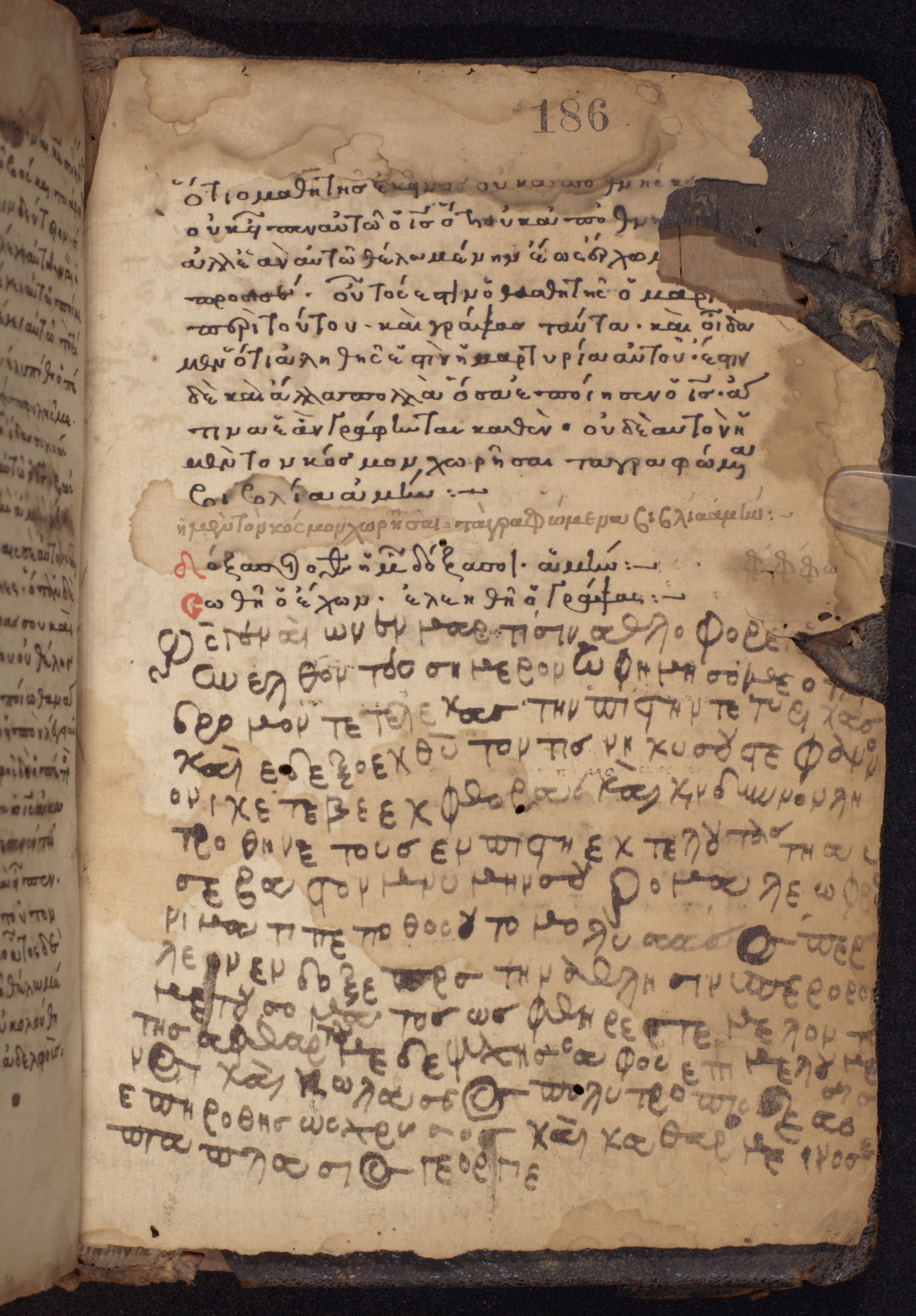
Fol. 186r of GA L1681 containing a scribal colophon to conclude the work
GA L1682 Bibelmuseum Ms. 14
Gospel lectionary on paper with 131 leaves (270x145 mm), 1 column with 24 lines per folio
Dated to the 16th century, L1682 along with L1686 are the two youngest Greek New Testament witnesses in our collection. The leaves were heavily trimmed at the outer edge, so that sometimes parts of letters at the beginning or end of lines are lost. The middle part of the manuscript is well preserved but the front and back parts are quite badly damaged, and in some places the text of parts of the pages has been restored.

Fol. 123r of GA L1682 showing trimming and where sections have been patched
GA L1683 Bibelmuseum Ms. 15
13th century Gospel lectionary on parchment with 241 leaves (295x220 mm), 2 columns with 26 lines per folio
This lectionary, containing Gospel readings for every day of the year is embellished with oversized initials at the start of lections. One headpiece seems to have been left unfinished.

Fol. 81 of GA L1683
GA L1684 Bibelmuseum Ms. 1
13th century Gospel lectionary, parchment palimpsest with 166 leaves (270x210), 2 columns and 23-26 lines per folio
The undertext of this artefact is majuscule 0233. Interestingly, the upper text is also written in two columns of the same width as the under text. Some of the parchment leaves were later (16th century?) replaced by paper (fol. 1-38, 68, and 129-164). On the supplemental paper folios, it seems the copyist attempted to imitate the original scribe's handwriting but opted to use red for initials and decorations.

Fol. 60r and 68r of GA L1684 showing how the later scribe (right) tried to imitate the work of the former (left)
GA L1685 Bibelmuseum Ms. 16
15th century lectionary on paper with 264 leaves (275x190 mm), 2 columns with 31 lines per folio. This is the only lectionary in the collection with both Gospel and Apostolos readings for every day of the year.
The initials at the beginning of each lesson are decorated and extend over several lines. Before larger sections, such as between the Synaxarion and the Menologion, there are smaller ornamentations colored in red, yellow and green. The text has evidently been copied very hastily; there are numerous omissions resulting from eye leaps that a later scribe had to remedy. On several pages in the margins there are various notes and scribbles.
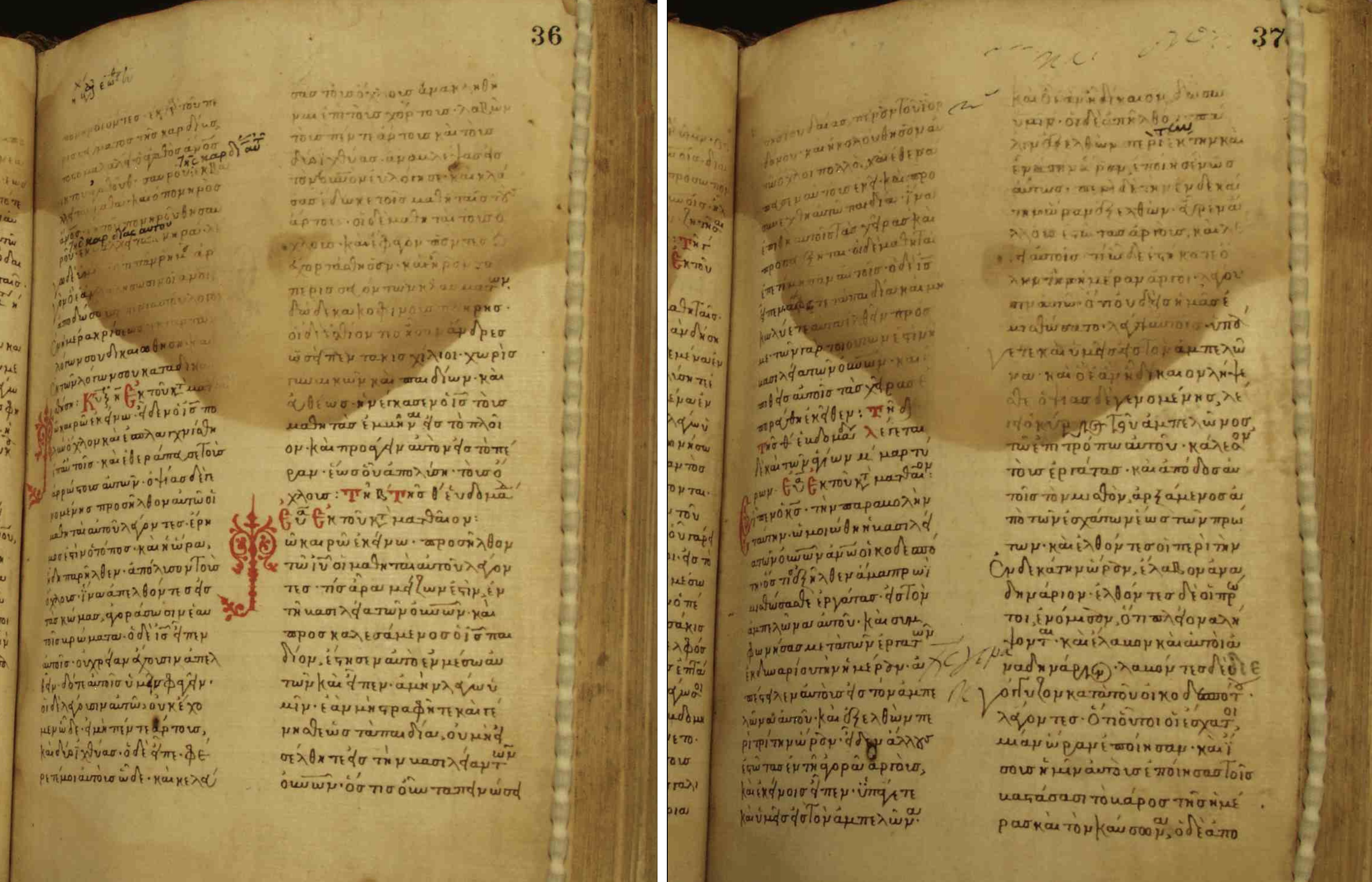
Marginal notes and corrections on fol. 36 and fol. 37 in GA L1685
GA L1686 Bibelmuseum Ms. 13
16th century lectionary on paper, 184 leaves with the Gospels and Apostolos (205x150 mm), 1 column with 17 lines
This is not a lectionary proper, but another liturgical book that has extensive readings from the New Testament. The manuscript provides various clues about its owners. On fol. 1r, next to a curse against potential thieves, a sakelarios, who probably belonged to a priesthood, is named, and on fol. 2r a priest named Athanasios is referenced. On the last page (fol. 184r) there is a dedication note dated 1624 by a certain Sterianos to the church of Taxiarches (παμμεγίστων ταξιαρχῶν) in memory of his parents.

Fol. 2 of GA L1686, opening page of the codex
GA L2005 Bibelmuseum Ms. 20
10th century majuscule lectionary on parchment, 1 leaf (320x235 mm), 2 columns with 19 lines per folio
This is the only majuscule lectionary, and also the oldest lectionary in the collection. All but three leaves have gone missing. Two leaves are at the Byzantine and Christian Museum in Athens (σπ. 42). Our leaf contains readings from John 16:24-17:3, part of the passion narratives.
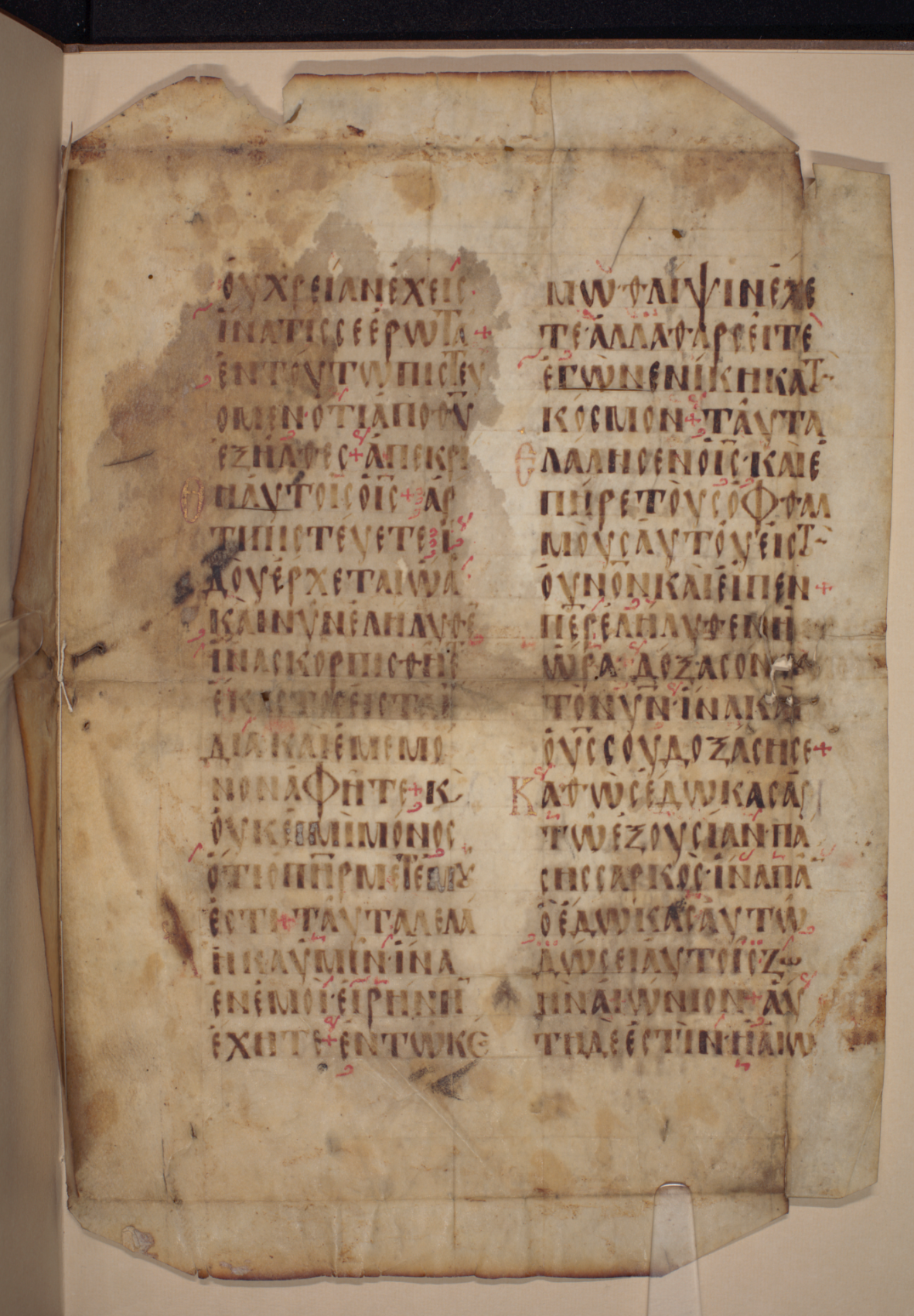
Recto of the single folio of GA L2005 located in the Bible Museum
GA L2137 Bibelmuseum Ms. 17
12th century Gospel lectionary on parchment with 213 leaves (320x245 mm), 2 columns with 24-27 lines per folio
Like L1683 and L1685, this lectionary contains Gospel readings for every day of the year.
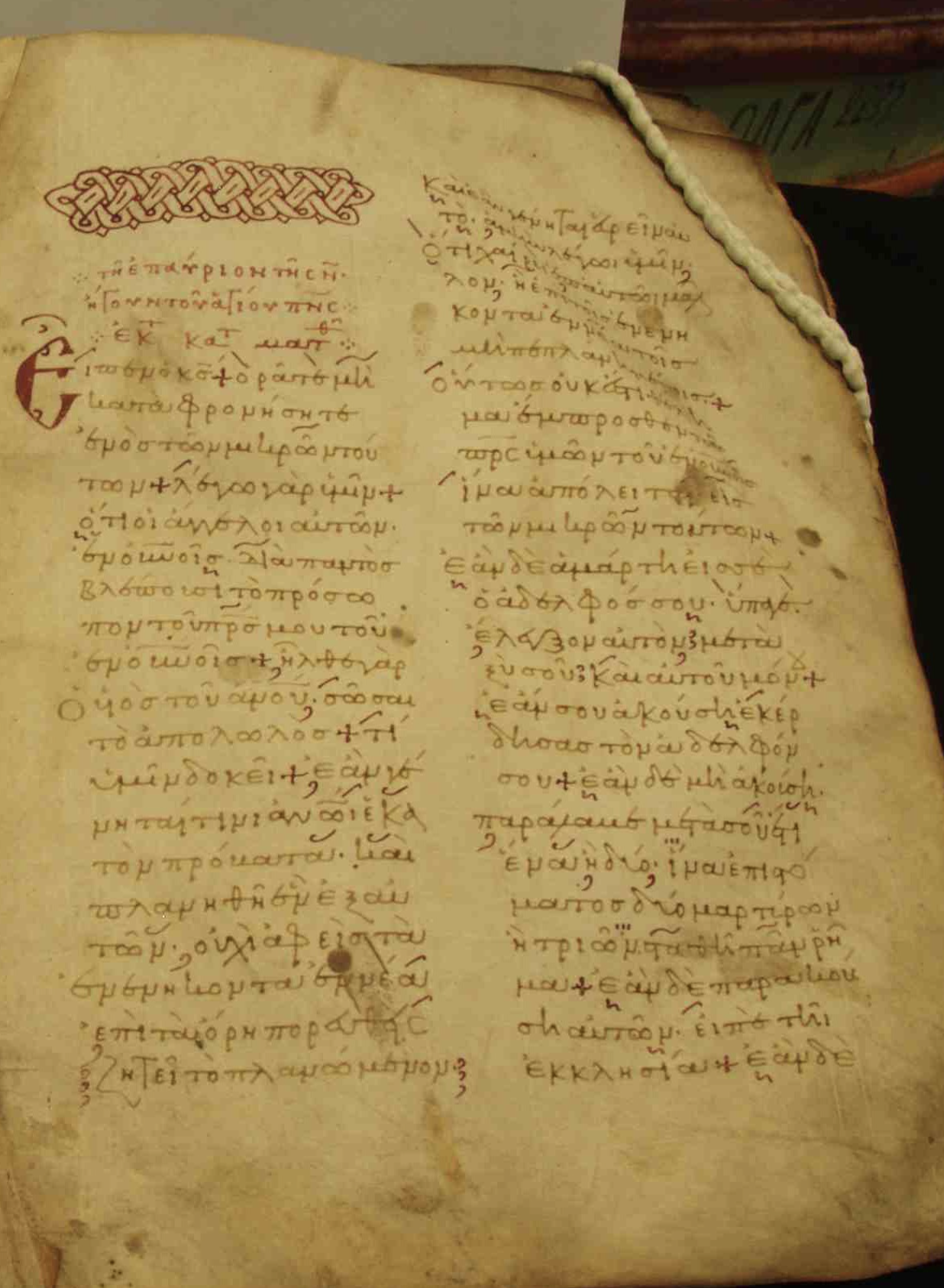
Fol. 38r of GA L2137 shows the ecphonetic notation and the red braided bands that separate the different sections of the lectionary.
GA L2208 Bibelmuseum Ms. 18
11th/12th century Gospel lectionary with 207 leaves on parchment (223x170 mm), 2 columns with 25 lines
This colorful lectionary has decoration dividing the reading units in carmine red and green. The headings indicating the book and the day are often highlighted in yellow—sometimes with red and green initial letters, as are the cross-shaped dots in the text to mark reading breaks, and capital letters to mark paragraphs.
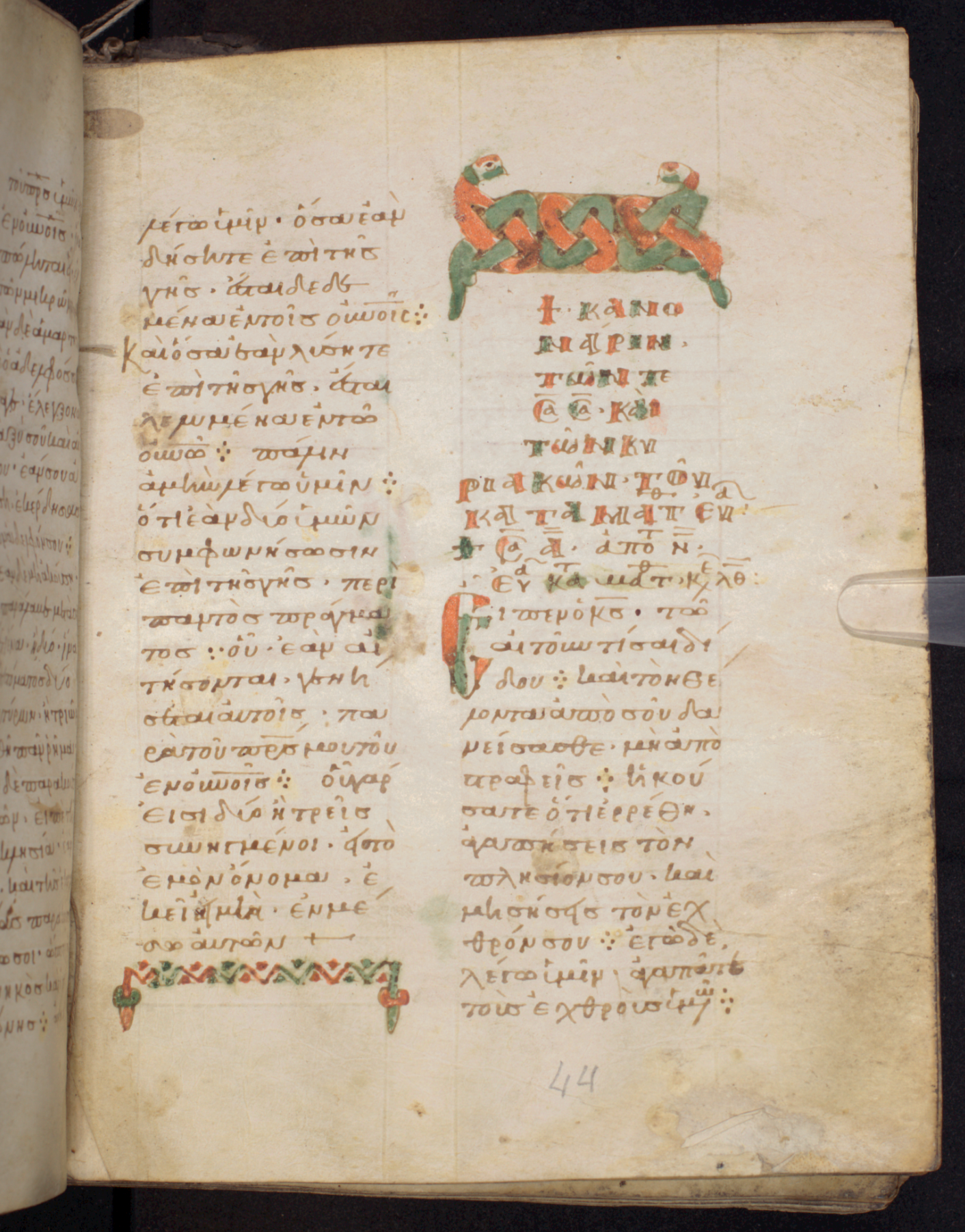
Fol. 44r of GA L2208 showing the beginning of the Matthean period of readings
GA L2276 Bibelmuseum Münster Ms. 21
13th/14th century Gospel lectionary on parchment with 55 leaves (292x230 mm), 2 columns with 28 lines
The manuscript contains many large gaps; of the original 140-150 leaves only about a third are preserved. The sections of the lectionary are separated by small, braided bands or decorative strips in red. The day information in the upper margin, the subheadings, the bookmarks and the ornate, oversized initials at the beginnings of the lessons are also written in red.
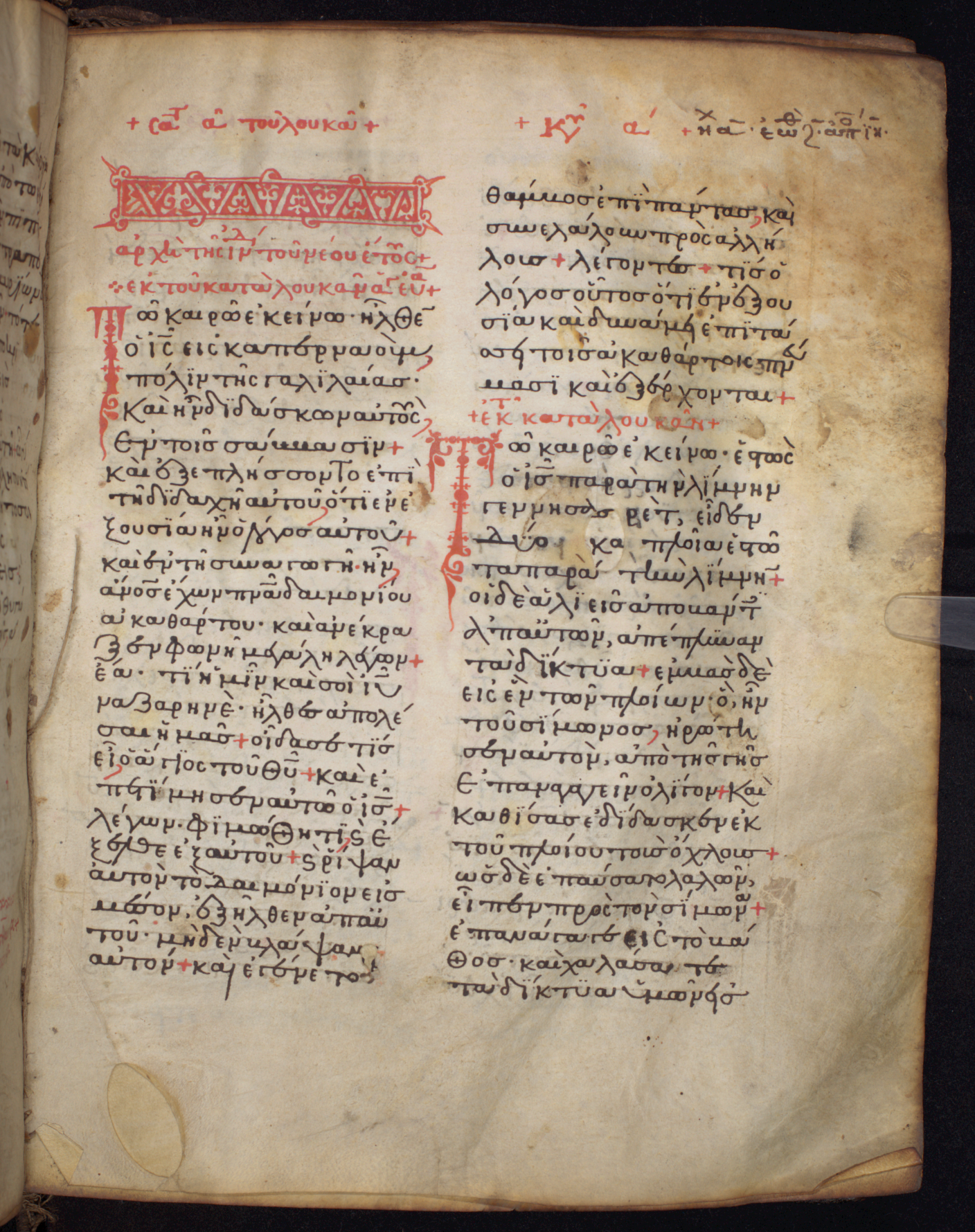
Fol. 15r of GA L2276 shows the beginning of the Lukan section
We hope you enjoyed these brief descriptions of the manuscripts in our collection. For those whose interest has been piqued, you can go here to the NTVMR to see full images.
Or better yet, come visit us in person at the Bible Museum in Münster!
[1] Many of the original manuscripts in the collection came from Bishop Hermann Kunst who donated his private collection to the Evangelical Church in Germany (EKD), stipulating they should be kept by the Hermann Kunst-Stiftung and displayed in the Bible Museum. Others came from the collection of the Loverdos Museum in Athens and a few from private auction houses and antiquarian bookshops.
[2] The largest collection is the Bavarian State Library in Munich with 30 Greek NT witnesses followed by the State Museum in Berlin with 25.
[3] Martin Schøyen loaned 0301 to the Bible Museum over 20 years ago and graciously donated the piece to the Hermann Kunst-Stiftung in 2023.
 Personal Blogs
Personal Blogs  RSS (Opens New Window)
RSS (Opens New Window)  Recent Bloggers
Recent Bloggers 








